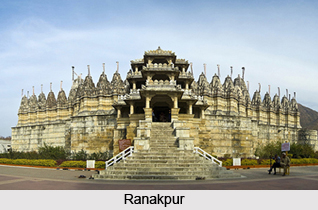 Ranakpur is located 90 kilometers northwest of Udaipur. It is also accessible from Kumbhalgrah. The main attraction here is the Ranakpur Jain Temple. Beautifully carved they date back to the 15th century. Lying in a remote valley of the Aravalli range it is one of five holiest Jain sites.
Ranakpur is located 90 kilometers northwest of Udaipur. It is also accessible from Kumbhalgrah. The main attraction here is the Ranakpur Jain Temple. Beautifully carved they date back to the 15th century. Lying in a remote valley of the Aravalli range it is one of five holiest Jain sites.
It is dedicated to Adinath, Jain Tirthankara. The construction of the temple started from the 15th century. The land for the temple was donated by Rana Kumbha. The main temple is Chaumukha Temple. It has 29 halls supported by 1444 pillars and built in creamy marble. Every nook and corner of the temple is engraved with Jain sculptures. The quadruple image of Adinath stands in the main sanctuary, which is open on all four sides.
Apart from the temple there is Rawla Narlai Fort. Built in the 17th century it was renovated by Maharaj and Rani Swaroop Singh. Located away from the hustle bustle of city life the serenity of the place is quite impressive. The fort is located midway between Udaipur and Jodhpur. Presently the fort has been converted into a heritage hotel. Though it provides all kinds state of the art facilities the old charm is still kept intact.





















